Types of fire extinguisher – all you need to know, explained in our uncomplicated guide.
There are 5 main fire extinguisher types – Water, Foam, Dry Powder, CO2 and Wet Chemical. You should have the right types of fire extinguisher for your premises, or you may not meet current regulations.
The various types of fire extinguisher put out fires started with different types of fuel – these are called ‘classes’ of fire. The fire risk from the different classes of fire in your business premises will determine which fire extinguisher types you need.
You will also need to make sure that you have the right size and weight of fire extinguisher as well as the right kind.
Whilst there are 5 main types of fire extinguisher, there are different versions of both the Water and Dry Powder extinguishers, meaning there are a total of 8 fire extinguisher types to choose from. The 8 types of fire extinguisher are:
-Water
-Water Mist
-Water Spray
-Foam
-Dry Powder – Standard
-Dry Powder – Specialist
-Carbon Dioxide (‘CO2’)
-Wet Chemical
There is no one extinguisher type which works on all classes of fire.
Below is a summary of the classes of fire, and a quick reference chart showing which types of extinguisher should be used on each. We then provide a detailed explanation of each type of fire extinguisher below.
The classes of fire
There are six classes of fire: Class A, Class B, Class C, Class D, ‘Electrical’, and Class F.
- Class A fires – combustible materials: caused by flammable solids, such as wood, paper, and fabric
- Class B fires – flammable liquids: such as petrol, turpentine or paint
- Class C fires – flammable gases: like hydrogen, butane or methane
- Class D fires – combustible metals: chemicals such as magnesium, aluminium or potassium
- Electrical fires – electrical equipment: once the electrical item is removed, the fire changes class
- Class F fires – cooking oils: typically a chip-pan fire
Which fire extinguisher types are used for each class of fire? – quick guide
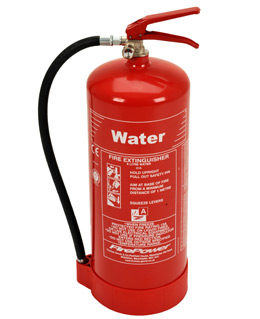
Water Extinguishers
This extinguisher requires an Extended service every 5 years
Overview:
Water extinguishers are the most common fire extinguisher type for class A fire risk. Most premises will require either water or foam extinguishers.
Label Colour: Bright Red
Use for:
Organic materials such as:Paper and cardboard, Fabrics and textiles, Wood and coal
Do not use for: Fires involving electrical equipment, Kitchen fires
Flammable gas and liquids.
How water extinguishers work:
The water has a cooling effect on the fuel, causing it to burn much more slowly until the flames are eventually extinguished.
Types of premises/business who may need water extinguishers:Buildings constructed of wood or other organic materials, premises where there are organic materials to be found such as: Offices' Schools, Hospitals, Residential properties, Warehouses, In fact most buildings need either water or foam extinguishers.
Where to locate water extinguishers:
By the exits on a floor where a Class A fire risk has been identified
Water spray extinguishers – what’s the difference?
Water spray extinguishers are equipped with a spray nozzle, rather than a jet nozzle, meaning a greater surface area can be covered more quickly and the fire put out more rapidly.
Water mist extinguishers – what’s the difference?
Water mist extinguishers have a different type of nozzle again which releases microscopic water particles. These particles ‘suffocate’ the fire and create a wall of mist between the fire and the person using the extinguisher, reducing the feeling of heat.
Contact us to buy water fire extinguishers
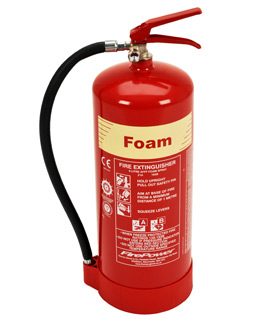
Foam Extinguishers
This extinguisher requires an Extended service every 5 years
Overview:
Foam extinguishers are most common type of fire extinguisher for Class B fires, but also work on Class A fires as they are water-based.
Label Colour: Cream
Use for: Organic materials such as:Paper and cardboard
Fabrics and textiles, Wood and coal
Plus:
Flammable liquids, like paint and petrol,
Do not use for: Kitchen fires, Fires involving electrical equipment
Flammable metals
How foam extinguishers work:
As with water extinguishers, foam extinguishers have a cooling effect on the fuel. On burning liquids, the foaming agent creates a barrier between the flame and the fuel, extinguishing the fire.
Types of premises/business who may need Foam extinguishers:
Buildings constructed of wood or other organic materials, premises where there are organic materials to be found such as: Offices, Schools, Hospitals, Residential properties, Warehouses, Buildings where flammable liquids are stored, In fact most buildings need either water or foam extinguishers
Where to locate foam extinguishers:
By the exits on a floor where a Class A or Class B fire risk has been identified
Contact us to buy foam fire extinguishers
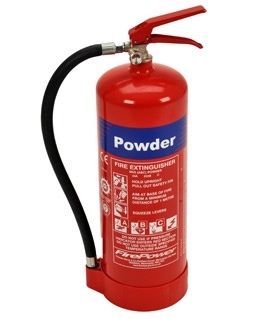
Dry Powder Extinguishers
This extinguisher requires an Extended service every 5 years
Overview:
Standard dry powder extinguishers are also called ‘ABC’ extinguishers because they tackle class A, B and C fires, however they are not recommended for use in enclosed spaces. This is because the powder can be easily inhaled, and also the residue is very difficult to clean up after. ABC powder extinguishers can also be used on some electrical fires. Specialist dry powder extinguishers are used for flammable metals.
Label Colour:
Blue
Use for:
Organic materials such as: Paper and cardboard, fabrics and textiles, wood and coal
Plus: Flammable liquids, like paint and petrol
Plus: Flammable gases, like liquid petroleum gas (LPG) and acetylene
Plus: Fires involving electrical equipment up to 1000v, specialist dry powder extinguishers are only used on flammable metals, such as titanium and magnesium.
Do not use for:
Fires involving cooking oil, Fires involving electrical equipment over 1000v or in enclosed spaces, such as offices or residential properties
How dry powder extinguishers work:
Dry powder extinguishers smother fires by forming a barrier between the fuel and the source of oxygen.
Types of premises/business who may need Dry Powder extinguishers:
Businesses using flammable gases for chemical processes, premises where welding and flame cutting takes place, garage forecourts, liquid petroleum gas (LPG) dispensing plants, premises with large, commercial boiler rooms
Where to locate Dry Powder extinguishers:
Place dry powder extinguishers near to the source of the fire risk.
Specialist Dry Powder extinguishers – what’s the difference?:
Specialist dry powder extinguishers work in the same way as standard dry powder extinguishers but are for use with flammable metals only. There are 2 types of specialist dry powder extinguishers – ‘L2’ which only tackles lithium fires, and ‘M28’, for all other flammable metal fires.
Contact us to buy dry powder fire extinguishers
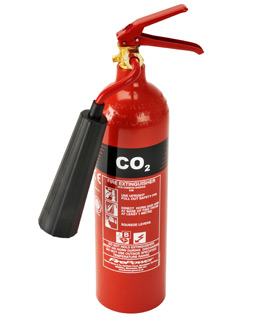
Carbon Dioxide Extinguishers
This extinguisher requires an Extended service every 10 years
Overview:
CO2 extinguishers are predominantly used for electrical fire risks and are usually the main fire extinguisher type provided in computer server rooms. They also put out Class B fires (flammable liquids, such as paint and petroleum).
Label Colour:
Black
Use for:
Flammable liquids, like paint and petrol, electrical fires
Do not use for:
Kitchen fires – especially chip-pan fires, combustible materials like paper, wood or textiles, flammable metals
How CO2 extinguishers work:
CO2 extinguishers suffocate fires by displacing the oxygen the fire needs to burn.
Types of premises/business who may need CO2 extinguishers:
Premises with electrical equipment, such as: Offices, Kitchens, Construction sites. Server rooms
All work vehicles should also carry a smaller 2kg CO2 extinguisher.
Where to locate CO2 extinguishers:
Place near to the source of the fire risk and/or near the fire exits.
Contact us to buy CO2 fire extinguishers
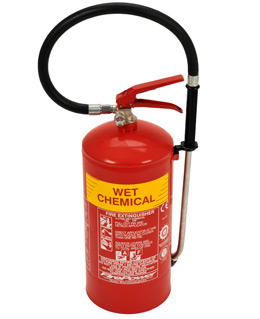
Wet Chemical Extinguishers
This extinguisher requires an Extended service every 5 years
Overview:
Wet chemical extinguishers are designed for use on Class F fires, involving cooking oils and fats. They can also be used on Class A fires although it is more usual to have a foam or water extinguisher for this type of fire risk.
Label Colour:
Yellow
Use for:
Cooking oil/fat fires, organic materials such as: Paper and cardboard, fabrics and textiles, wood and coal
Do not use for:
Flammable liquid or gas fires, electrical fires, flammable metals
How wet chemical extinguishers work:
Wet chemical extinguishers create a layer of foam on the surface of the burning oil or fat, preventing oxygen from fuelling the fire any further. The spray also has a cooling effect.
Types of premises/business who may need Wet Chemical extinguishers:
Commercial kitchens, canteens
Where to locate Wet Chemical extinguishers:
Place near to the source of the fire risk.
Contact us to buy wet chemical fire extinguishers
We hope this guide to the several types of fire extinguisher has been helpful. If you still have questions, or if you’d like to book a free survey of your premises by one of our extinguisher engineers, please just call us on 0121 783 4329 or use or contact page

